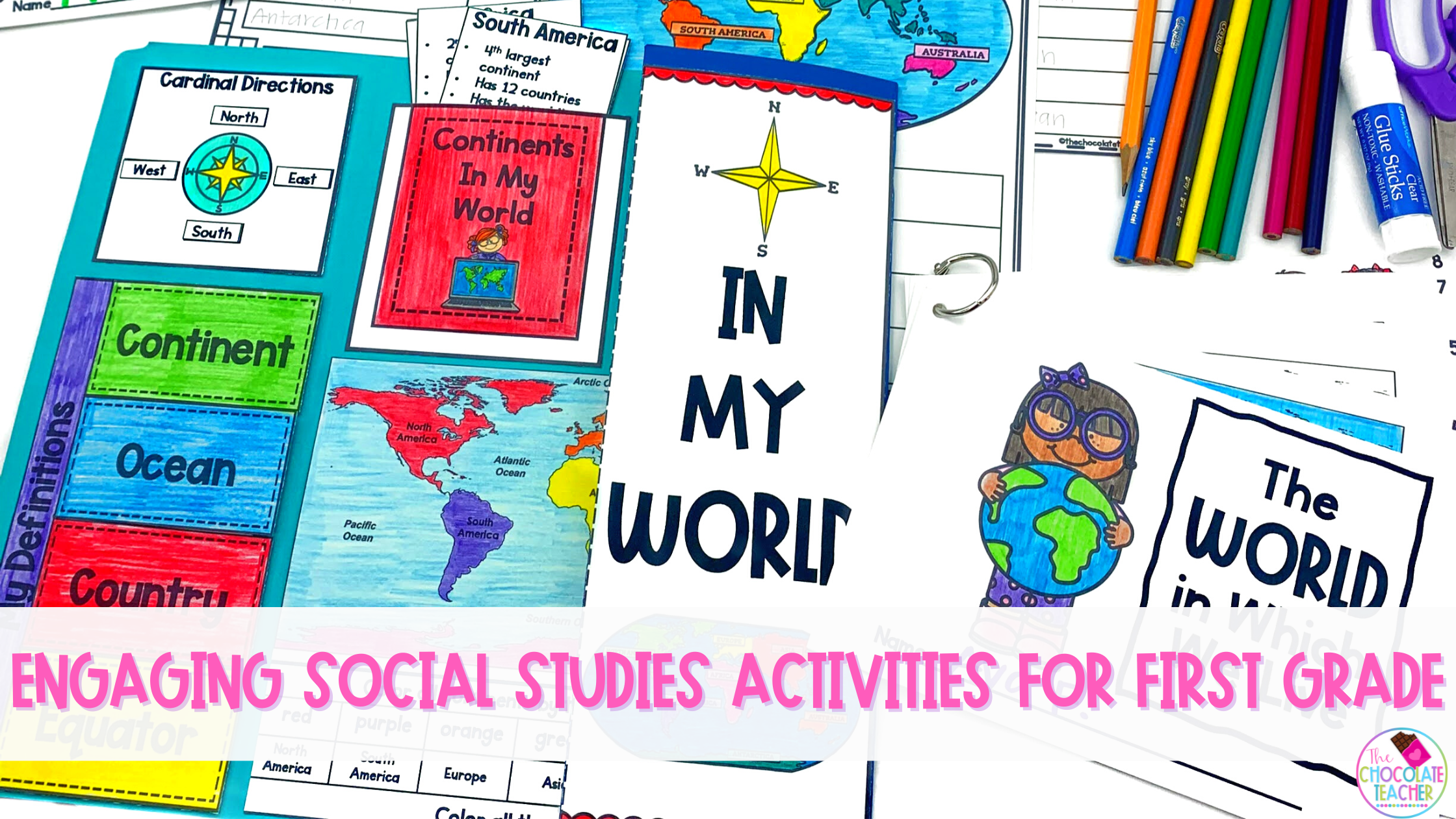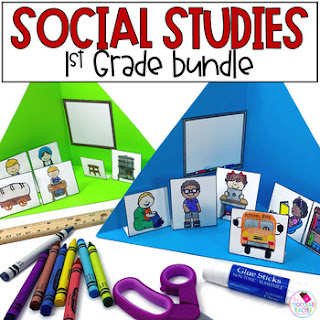Social Studies in the Primary Classroom: Our Topics
First things first, what topics are taught in first-grade social studies? So glad you asked! In first grade, we're expanding on the community-based topics covered in kindergarten and branching out a bit further. Specifically, the first-grade curriculum tends to focus on civics, basic economics, geography, and history.
In my room, this translates to units on good citizenship, financial literacy, map skills, continents, oceans, and studies of past, present, and future. These topics allow my students to learn a bit of background on generations of the past, the world around them, and how to be productive members of society. When it comes to planning social studies units, my goal is always to provide a well-rounded look at the world around us in a digestible way.
I love that these topics also help students reflect on their lives, their community, and why all of this matters. Social studies is a subject that prompts deeper thinking and conversations among my students. I love diving into these topics as a class and hearing my students' takeaways each month!
Social Studies Scope and Sequence
The scope and sequence in which social studies topics are taught is often decided by the district, though I have noticed that some schools are a bit more relaxed on the order social studies is taught compared to other subjects, like math and ELA. If you're left in charge of planning your own sequence for your social studies lessons and not sure how to approach it, let's get it mapped out together!
In my class, we follow a similar sequence each year. In the fall, we focus on good citizenship right off the bat. This is an important topic to cover in the first few weeks of school to help set the tone for the year. Following this unit is map skills, which is always a class favorite.
Once your students understand maps, it's fun to dive into oceans and continents. In my classroom, this typically falls around November. I love tying this into the story of the first Thanksgiving to show my students where the Pilgrims came over from on the Mayflower.
We finish up the first semester with some cultural studies as we dig into Holidays Around the World.
After the holiday break, we spend the next couple of months working on past, present, and future. This is a BIG topic in first grade and involves a few smaller units to break it up. We talk about personal timelines, schools, communication, transportation, and cooking.
Once we hit the spring, it's time to focus on an intro to economics with financial literacy. This is SUCH a fun topic for young students who are just beginning to learn about money, goods, and services. And finally, our last unit of the year is typically on American symbols. I love ending the year with this since Memorial Day is near and Independence Day is just around the corner. I also know many teachers who start their American symbols unit in February around President's Day.
This is, of course, just a suggestion. The great thing about social studies is that you can adapt it to fit the needs of your group. If you think your students would benefit more from another sequence, feel free to mix it up!
How to Teach Social Studies - My Method
When it comes to actually teaching each of these topics, I have a specific method of instruction I always lean toward. This tried and true style of teaching has evolved as I've seen what works, and what doesn't, in my classroom. If you're trying to find a new way of covering social studies, check out some of my favorite ways to make the content stick!
Begin with a Fantastic Introduction
As with any new topic in the classroom, the way it is introduced is directly tied to how your students will perceive it. What I mean by this is that when you introduce something in a bit of a dreary tone, with the "same-old-same-old" approach you can't expect your students to jump for joy.
No, if we want excitement and high engagement, there's got to be a bit of drama in the introduction! When it comes to social studies, I always play up the introduction to build some excitement among my group. You can do this in a number of ways, but I'm quite fond of songs, short videos, dress-up items, and props.
For example, let's say you're introducing map skills to your students. What better way to introduce the importance of maps than with a pirate-themed adventure? Can you imagine the enthusiasm you'd see if you snuck off to the back corner of the room and reappeared with an eye patch and pirate hat?! This simple costume is enough to get a wave of excitement rolling through your classroom and will make teaching the topic fun and easy. Once you've got their attention, try a fun video like this one that discusses maps and how they're useful.
Or maybe you're working on American symbols with your kiddos. Grab a fun pair of patriotic sunglasses like these, a mini American flag, and flip on the National Anthem to kick off the fun! Follow this up with a discussion on symbols and real-life pictures of American symbols to help introduce your new unit in a fun way.
No matter what you choose to do, make your initial introduction count. It will make a world of difference when it comes to maintaining student attention throughout the course of your new study.
Expand on the Intro with Group Learning
After we've had our first peek at our new topic, it's time to dive into more focused learning activities. To begin, I love using mini-readers for each new unit. I like to read the book aloud and then have children take turns reading pages together.
After we've read our books, we often work on sorting and matching definition cards, discussing new vocabulary words in-depth, and working on practice worksheets that reinforce what we've learned. These activities will vary by unit, but generally, they include question-and-answer pages, matching, vocabulary work, and writing prompts. These are great for whole-group instruction, small groups, centers, and even homework assignments.
Explore Further with Research Projects
If you're having way too much fun with your current study to let it end, consider taking your social studies projects a step further with research projects. In first grade, this will more than likely be your student's first experience with researching a topic, and it's a great way to help facilitate deeper learning!
My favorite way to use research projects is with small groups and assigning a topic to each one. For example, continents is a great topic for this, since each group can focus on a different one. Once the topics are divided up, it's time to hit the library and find some books to use in your studies! I have students check out a book that relates to their topic, or I will head to the library myself and distribute them to my kiddos accordingly.
You can also find a short video for each group to watch as well. Check out YouTube, there are great videos on just about everything! Just be sure to preview it first to make sure it's classroom-appropriate. Oh, and don't forget to refer back to the worksheets and mini-readers you used in your lessons!
Once the students have some learning materials to expand on their research, I allow this to get a bit free form. I provide students will posterboard and art supplies and encourage them to write down key facts and important vocabulary words, draw pictures, and highlight their big takeaways. The main idea here is to encourage children to find facts that are meaningful to them and teach the basic research process.
Have kiddos work on this in the afternoon for a couple of days, and then take turns presenting as a group when everyone is done. This is a memorable way to learn even more about your topic!
Use Fun Activities to Cement Social Studies Topics
My final strategy for teaching social studies is to add some kind of fun craft, or writing activity to sum the unit up. This is actually one of my favorite parts of the whole process! This varies by topic, but I'm always sure to include some kind of craftivity, lapbook, or 3D model that relates to our unit as we're wrapping up. These activities are sort of the "cherry on top" in our social studies units. My students always look forward to them, and they're a great way to review!
For example, when we're working on American symbols, we make a fun Uncle Sam craft, which is always a student favorite. This craft has foldable flaps that list all of the American symbols we learned. Students will cut, color, and paste each symbol to the correct word. Finally, they make a super cute Uncle Sam craft topper to finish it off. When we're working on Map Skills, students make a 3D town craft, and during our study of continents, students make a fun lapbook.
No matter what we're working on, using fun crafts like these is a great way to round out the unit and reflect on what you've learned as a class. Crafts are also great engagement boosters too, so if your class is fizzling out on a topic and losing focus, an activity like this one is a great way to reel them back in for a final hurrah!
Ready to Get Started?
Are you excited to start planning a full year of fun social studies activities for your classroom? If you said YES, be sure to take a peek at my bundle of social studies activities. This bundle includes ALL of my social studies units and takes the guesswork out of planning.
You'll have everything you need for a fun year of first-grade social studies lessons including introduction materials, vocabulary, worksheets, mini readers, and crafts! Grab this FREE sample of my financial literacy unit to get a feel for what you can expect from these units!
And if you're looking for more resources on teaching these topics specifically, be sure to check out these posts next:
- Introduction to Map Skills
- Teaching About Citizenship
- Making Student Timelines
- Past, Present & Future Activities
Pin It!
Pin this post on Pinterest to keep these social studies teaching ideas at your fingertips!


.png)
.png)

.png)
.png)






0 Comments